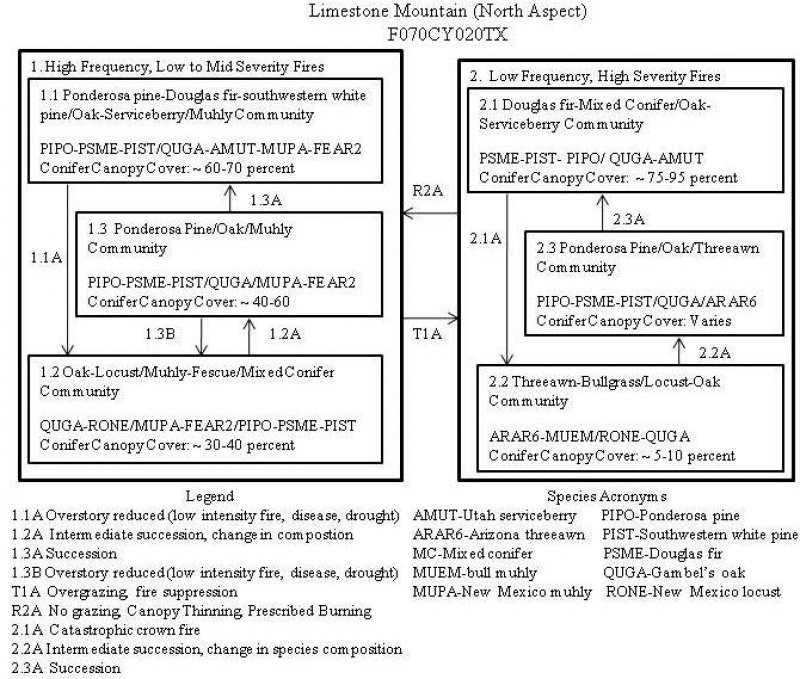Ecological dynamics
The reference plant community or potential for this site is considered to be a Ponderosa pine-Douglas fir-southwestern white pine coniferous forest. Common understory shrubs or small trees include Gambel’s oak, Utah serviceberry, mescalero currant. A mix of both warm and cool season grasses including New mexico muhly, mountain muhly, Arizona fescue, and nodding brome comprise the herbaceous grass layer. At the time of European settlement the site was most likely a heterogonous mix of plant communities that reflected the various stages of plant succession following natural disturbances. In addition to natural disturbances, forest composition is highly dependent on topographic position, elevation, and available soil moisture.
The natural disturbance that is the most influential driver of vegetation dynamics is fire. Historically, high frequency and low to mid severity fires shaped the plant communities (Ahlstrand 1980, Sakulich and Taylor 2007). In a fire scar study, Ahlstrand (1980) indentified a mean fire interval of 4.7 years for all fires occurring between 1554 and 1842. Most of these fires were sparked by lightening although some could have been started my Mescalero Apaches who inhabited the area in the 1800s. European settlement that introduced diseases and military campaigns brought an end to the Apache settlements. The reduction of fires slowly initiated during this time period. Other disturbances such as disease, falling of dead trees, and drought also influence the plant communities.
A community phase consisting of Gambel’s oak, New Mexico locust, and numerous warm season grasses establishes after disturbances. An intermediate seral stage with numerous ponderosa pine seedlings follows. It is unknown how long these seral stages can persist but precipitation and/or drought most likely plays a role.
At Guadalupe Mountains National Park, sheep and goat grazing began on this site in the 1920s about 40 years later that many similar areas in New Mexico. This coincides with the cessation of fire at the park (Sakulich and Taylor 2007). Overgrazing of livestock will reduce the fine fuels needed to carry fires and thereby increase the density of trees. A combination of fire suppression and fire will shift the dynamics of this forest ecosystem into an alternate state. A dense forest with abundant litter will be susceptible to large catastrophic fires that can lead to high tree mortality. High severity and low frequency fires would characterize this second state. Post-fire communities will establish but in large acreage and with some differences to the original state. Large sever fires is most likely more detrimental to wildlife than smaller more frequent fires.
The following diagram suggests general pathways that the vegetation on this site might follow. There are other plant communities and states not shown on the diagram. This information is intended to show what might happen in a given set of circumstances; it does not mean that this would happen the same way in every instance. Local professional guidance should always be sought before pursuing a treatment scenario.
State 1
High Frequency, Low to Mid Severity Fires State
This state is a multi-aged mixed coniferous forest characterized by high frequency, low to mid severity fires. Abundant fine fuels exist with a combination of both warm and cool season grasses and forbs to carry fires. A high frequency of fire would favor ponderosa pine over Douglas-fir in this state (NPS 2005). A total of three seral stages are identified in this state and they most likely occur in a mosaic of patches optimizing wildlife habitat. Forest health is also optimized thereby limiting the extent of diseases.
Community 1.1
Ponderosa Pine-Douglas fir-Southwestern White Pine/Oak-Serviceberry/Muhly Community
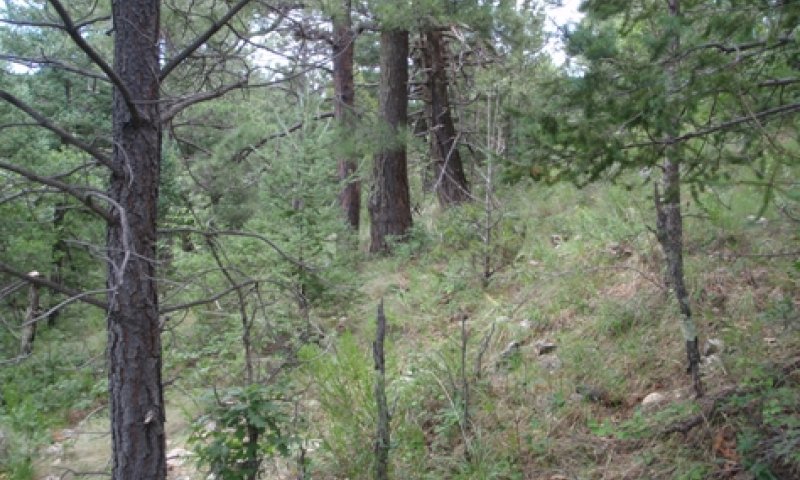
Figure 4. Approximate HCPC
This community is the potential or reference plant community. It is characterized by a slight dominance of ponderosa pine in the forest over-story although associated species such as Douglas fir and/or southwestern white pine can dominate favorable micro-sites such as drainageways. Gambel’s oak is a common understory tree. Other trees and shrubs include knowlton’s hophornbeam, Utah serviceberry, mescalero currant, cliff fendlerbush, and silver mountain mahogany. A combination of mid/tall grasses and warm/cool season grasses dominates the herbaceous layer. The occurrence of natural fires prevents this community from being a closed canopy throughout the extent of the site.
Table 5. Annual production by plant type
| Plant type |
Low
(lb/acre) |
Representative value
(lb/acre) |
High
(lb/acre) |
| Shrub/Vine |
1200 |
1500 |
1800 |
| Grass/Grasslike |
600 |
900 |
1200 |
| Total |
1800 |
2400 |
3000 |
Community 1.2
Oak-Locust/Muhly-Fescue/Mixed Conifer Community
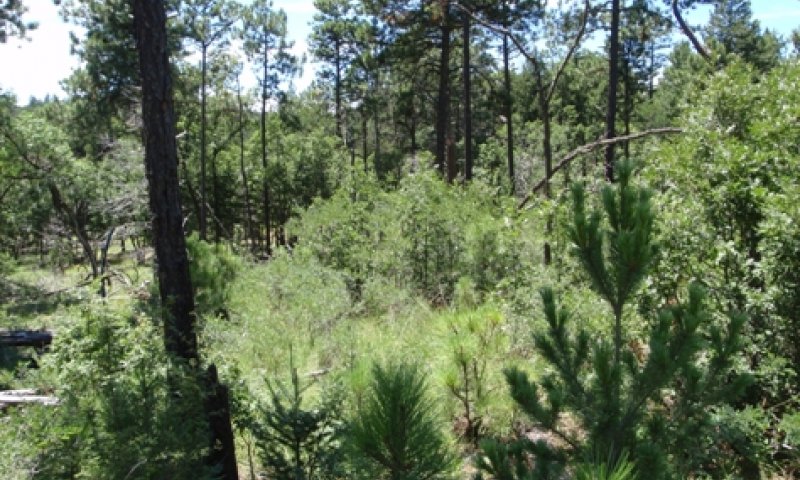
Figure 6. 1.2 Oak-Locust/Muhly-Fescue/Mixed Conifer
This community is characterized by a dominance of Gambel’s oak and New Mexico locust with abundant warm shade intolerant warm season grasses such as big bluestem, yellow indiangrass, little bluestem, and numerous muhly grasses. The community is in the early stages of secondary succession caused by fire, disease, and/or drought.
Community 1.3
Ponderosa Pine/Oak/Muhly Community
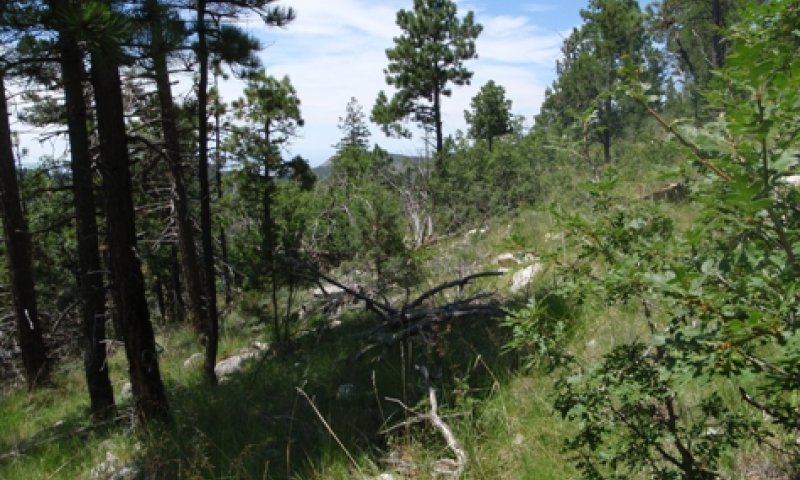
Figure 7. 1.3 Ponderosa Pine/Oak/Muhly Community
This community is an intermediate seral stage. Lack of fire or other disturbances is allowing succession to occur. Numerous seedlings of ponderosa pine as well as Douglas fir and southwestern white pine are being established. Shade intolerant warm season grasses dominate the grass layer.
Pathway 1.1A
Community 1.1 to 1.2
Ponderosa Pine-Douglas fir-Southwestern White Pine/Oak-Serviceberry/Muhly Community
Oak-Locust/Muhly-Fescue/Mixed Conifer Community
overstory canopy is reduced due to natural disturbances such as low intensity fires, disease, insects, and drought conditions.
Pathway 1.2A
Community 1.2 to 1.3
Oak-Locust/Muhly-Fescue/Mixed Conifer Community
Ponderosa Pine/Oak/Muhly Community
Due to intermediate succession and change of plant species composition, the Oak-Locust/Muhly-Fescue/Pine-Fir Community will shift to the Pine-Fir/Oak Community.
Pathway 1.3A
Community 1.3 to 1.1
Ponderosa Pine/Oak/Muhly Community
Ponderosa Pine-Douglas fir-Southwestern White Pine/Oak-Serviceberry/Muhly Community
The Pine-Fir/Oak Community can shift to the Douglas-fir-Pine/Oak-Serviceberry Community due to Plant Succession.
Pathway 1.3B
Community 1.3 to 1.2
Ponderosa Pine/Oak/Muhly Community
Oak-Locust/Muhly-Fescue/Mixed Conifer Community
Overstory reduced due to natural disturbances such as low intensity fire, disease, and/or drought.
State 2
Low Frequency, High Severity Fires State
This state is characterized low frequency, high severity fires. Overgrazing has been or is a part of this state and a very low grass cover exists. Dense thickets of coniferous exists due to the lack of periodic fires. Numerous young Douglas fir and Gambel oak trees exists in the understory of these thickets. The high density of Douglas fir in understory communities can likely shift the dominance from mixed ponderosa pine and southwestern white pine to Douglas fir (Sakulich and Taylor 2007). Large catastrophic wildfires can cause high tree mortalities in this state.
Community 2.1
Douglas-fir-Mixed Conifer/Oak-Serviceberry Community
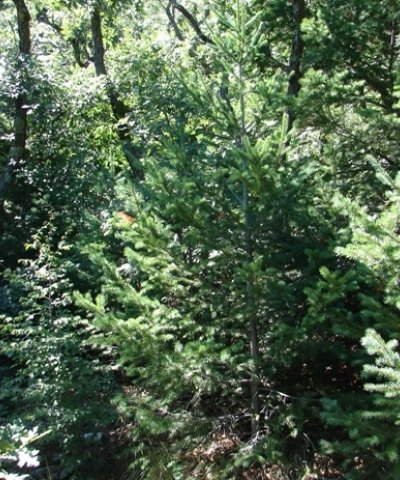
Figure 8. Douglas-fir-Mixed Conifer/Oak-Serviceberry
This community is characterized by a dominance of Douglas fir with associated ponderosa pine and southwestern white pine. Gambel’s oak is a common understory shrub or small tree. Few shade tolerant grasses exist. Canopy cover of trees can range up to 95 percent. Fine fuels needed to carry low severity fires are very limited.
Community 2.2
Threeawn-Bullgrass/Locust-Oak Community
Overstory of trees is greatly reduced due to a catastrophic crown fire. Mortality of coniferous can be very high with severe fires. Grasses such as Arizona threeawn, common in overgrazed areas will most likely be common as well shade intolerant grasses such as bull muhly. New Mexico locust and Gambel oak will be resprouting. Continued overgrazing will limit the recovery of grasses.
Community 2.3
Pine/Douglas-fir/Oak Community
Pathway 2.1A
Community 2.1 to 2.2
The Douglas-fir-Pine/Oak-Serviceberry/Muhly Community can shift to the Threeawn-Bullgrass/Locust-Oak Community due to catastrophic crown fires on the Douglas-fir and pine species.
Pathway 2.2A
Community 2.2 to 2.3
Intermediate plant succession through time.
Pathway 2.3A
Community 2.3 to 2.1
Due to plant succession, the Pine-Douglas-fir/Oak Community will shift back to the Douglas-fir/Pine/Oak-Serviceberry/Muhly Community.
Transition T1A
State 1 to 2
Due to overgrazing and fire suppression, the High Frequency Low to Mid Severity Fire State will transition into the Low Frequency, High Severity Fire State.
Restoration pathway R2A
State 2 to 1
With the use of Plant Succession, the Low Frequency High Severity Fires State can be restored back to the High Frequency Low to Mid Severity Fires State.


